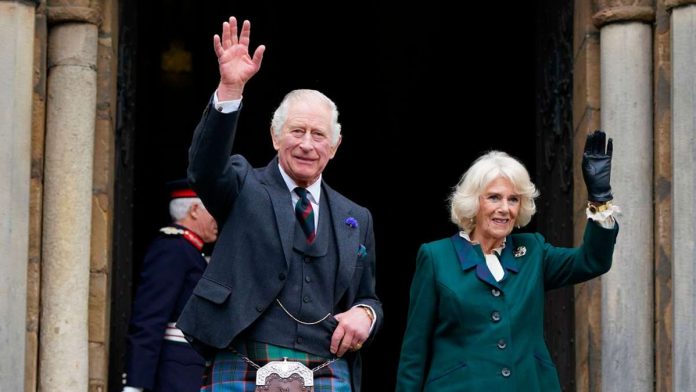Despite the new era in the British royal family, everyday royal life looks almost the same from the outside. But behind the scenes there are signs that a new wind is blowing at Windsor House.
DUNFERMLINE – Shaking hands, shaking hands of an enthusiastic crowd, more handshakes, some warm words here and there: King Charles III’s first public visit, taken on Monday in Dunfermline, Scotland, looks familiar.
Even as the heir to the throne, the 73-year-old has made hundreds of tours with his wife Camilla across the state and beyond. Is “business as usual” returning to the Royal Family after weeks of mourning for the deceased Queen? No because as the new king finds his way into everyday life, unfamiliar voices are already penetrating the walls of the palace.
He confirmed on Sunday that the king would not travel to the world climate summit in Egypt next month – on the advice of new British prime minister Liz Truss.
Charles – a long-time committed and well-connected pioneer of climate protection – is said to have already made plans and appointments for the summit. But as the British head of state, the king traditionally acts in agreement with the government – and under the new head of government the latter does not have an overly green agenda.
Charles was “personally disappointed”, an unnamed insider close to the king told the Sunday Times, which publicized the controversy. But he will find a way to raise his voice in international meetings despite his absence.
communication is a bit different
It is an open secret that Charles’ views may differ from those of the current Conservative government. A few months earlier, he revealed – at the time still the heir to the throne – that he thought the Tories’ plan to blow up asylum seekers in Rwanda was “sinister”. In his first speech as king, he expressed outright regret at not being able to support some of the concerns of his heart as before.
However, what is more interesting than disagreements is that the public should also find out about them. Royal experts speculated on Twitter that this would only be possible if Charles personally approved it. In the days of Queen Elizabeth II, people pondered endlessly about her personal opinion and perceived political allusions. But his strict restraint on these issues has become a trademark for decades.
The canceled climate mission is the first sign that Charles probably won’t even be charged in his new role. But it remains to be seen whether he risks an open confrontation with the government.
During his visit to Dunfermline, Charles also gave hints – albeit more subtle. Dressed in a blue and green checkered kilt, typical of the country, he congratulated the place on its new status as a free city, and recalled that a “deep love for Scotland” was the foundation of his mother’s life, something that died. Gone several weeks ago.
Charles emphasized the role of Scotland in the kingdom
The fact that Charles is the first to appear in the northernmost part of Britain is probably not only due to the fact that he spent extended periods of mourning there. It is also considered to belong to the Kingdom of Scotland and a strong sign of its solidarity. Hundreds of spectators gladly welcomed the royal couple on the rocky streets of Dunfermline, about 30 kilometers northwest of Edinburgh. Charles and Camilla also visited a medieval church there, where several previous Scottish kings were buried.
Later, the royal couple wanted to host people from Indian, Pakistani and other Asian communities representing Britain in Scotland at Holyrood Palace, the royal residence of Scotland. “It is very important to them,” commented historian Anthony Seldon, according to the BBC. “He wants to be accepted by all religions and groups and to be a unified individual.” Especially in turbulent political times, the emperor wants to be an institution that opposes divisive forces.

Freelance twitter maven. Infuriatingly humble coffee aficionado. Amateur gamer. Typical beer fan. Avid music scholar. Alcohol nerd.







